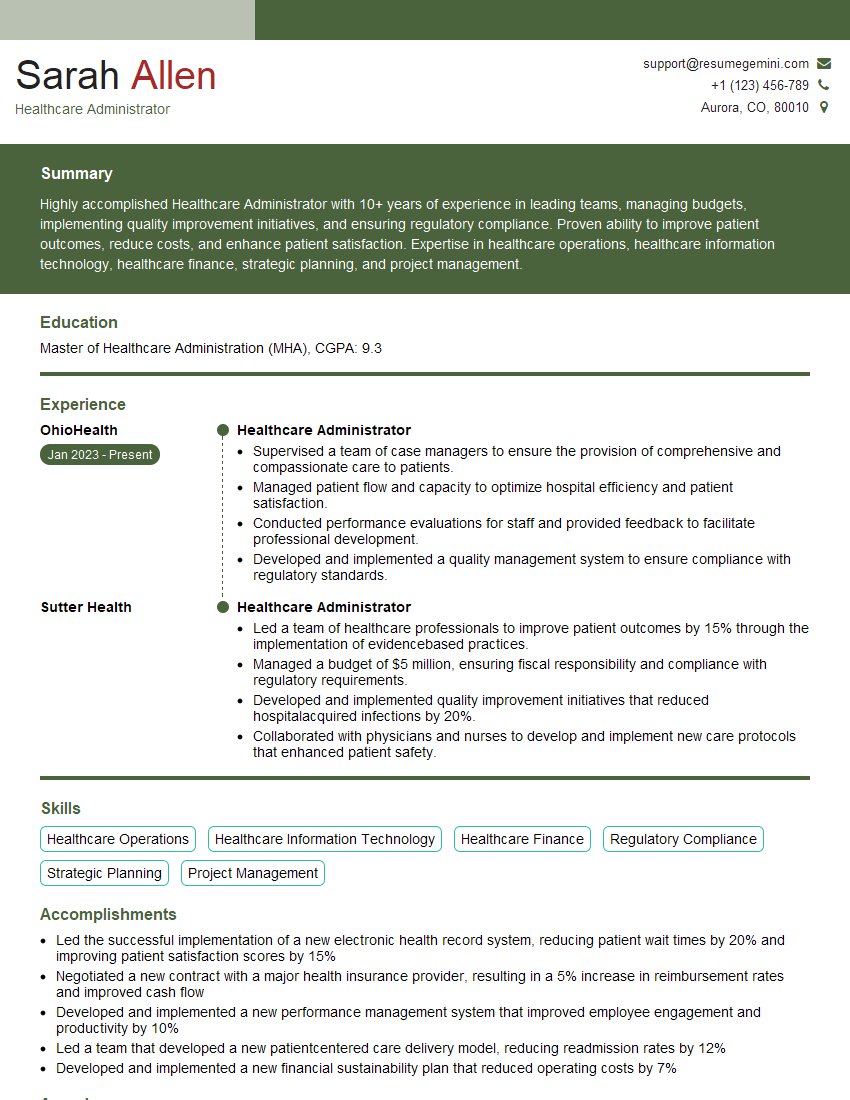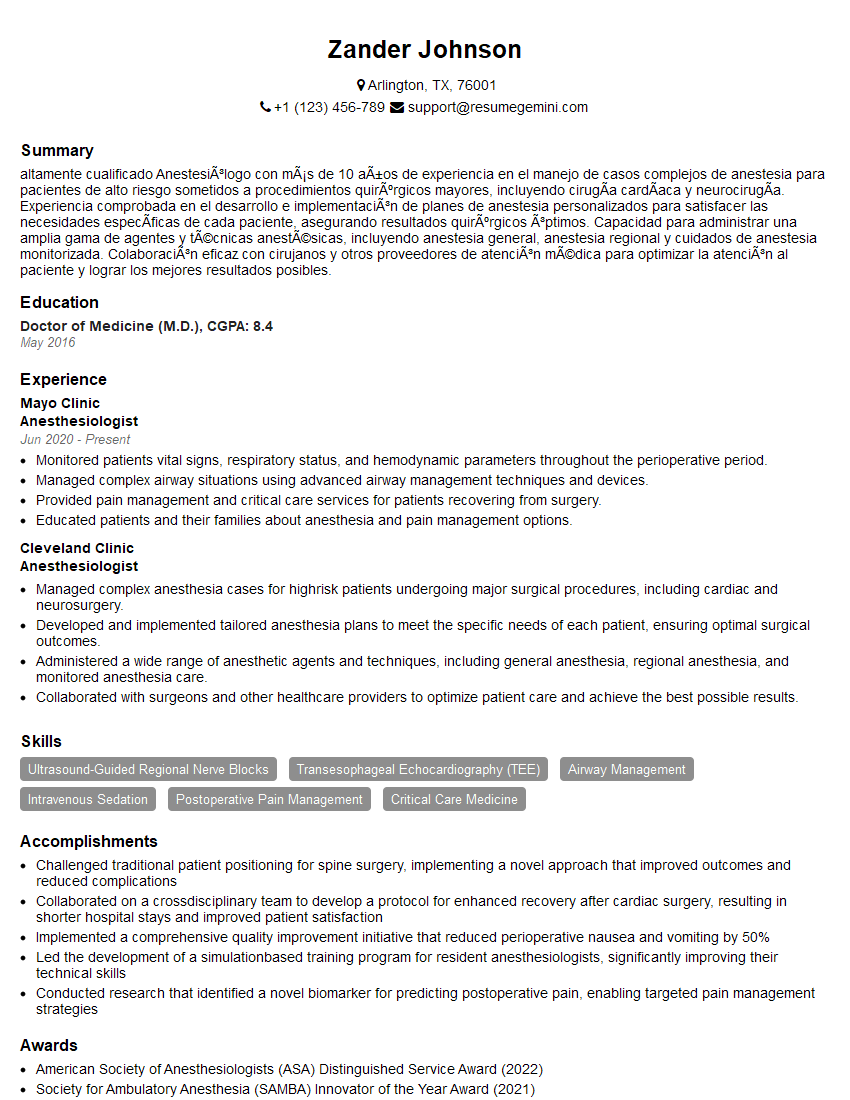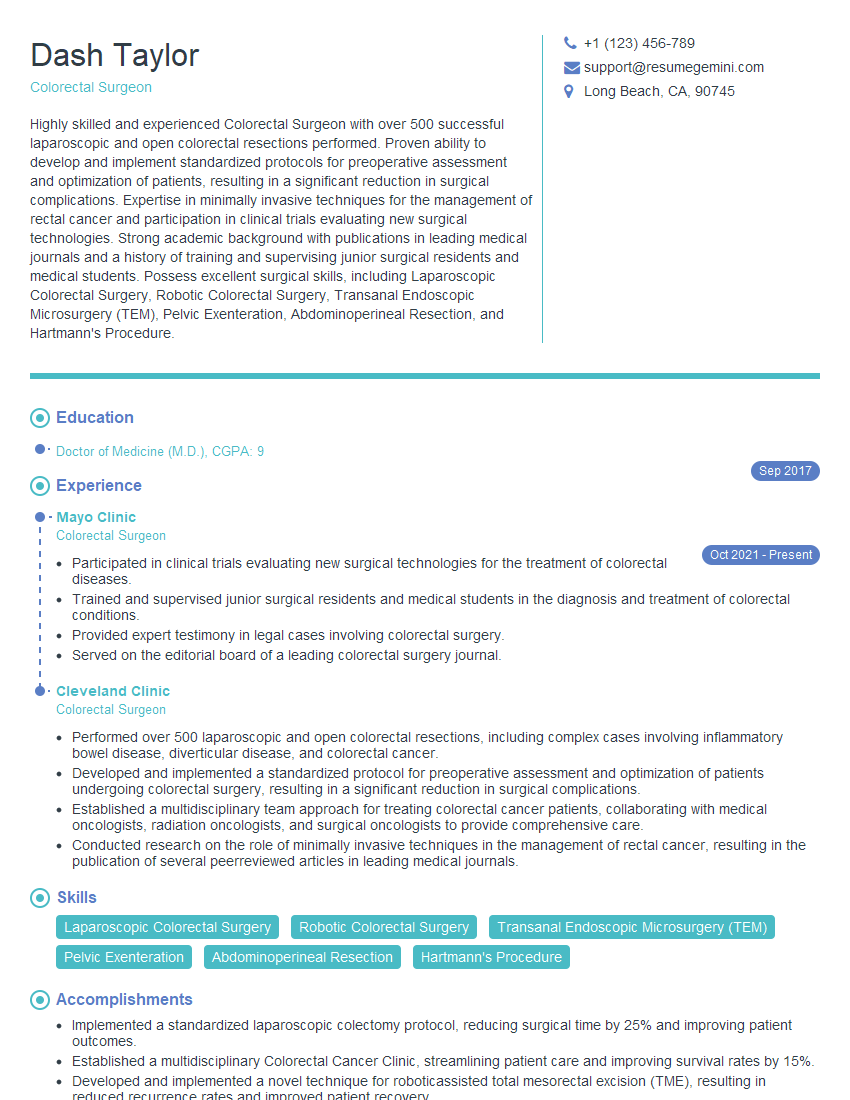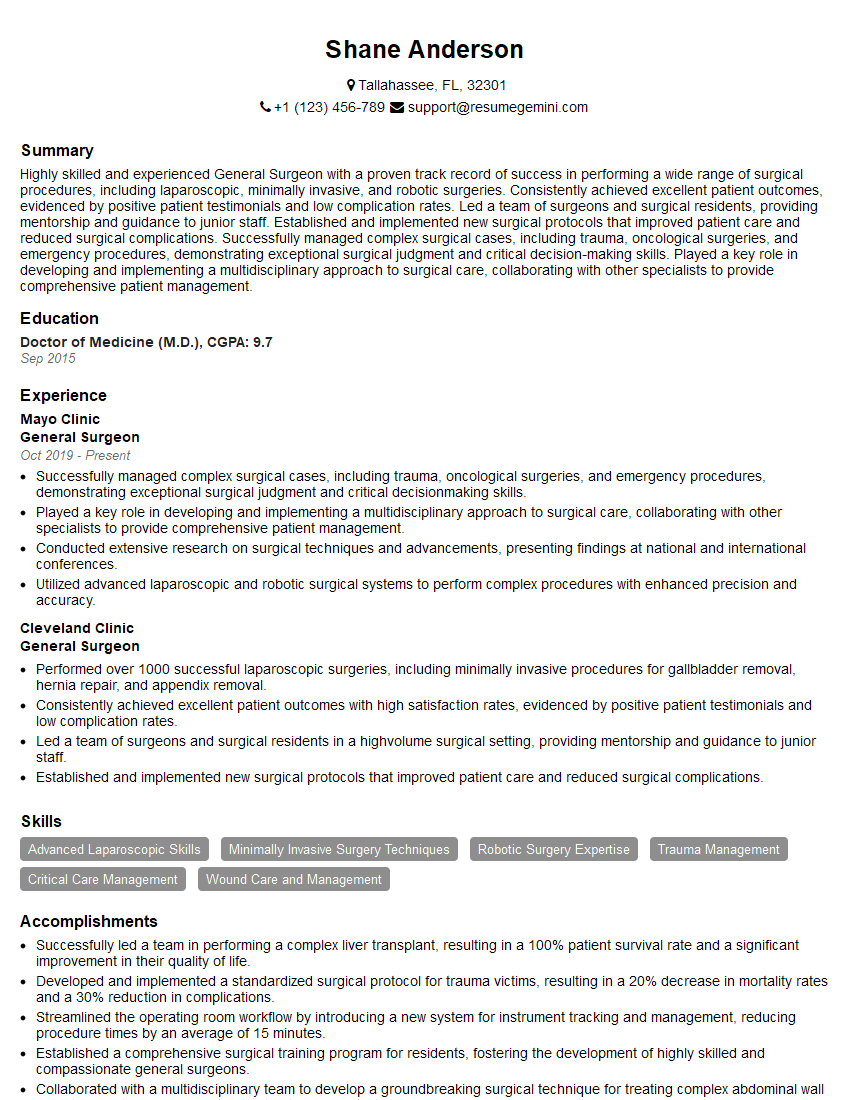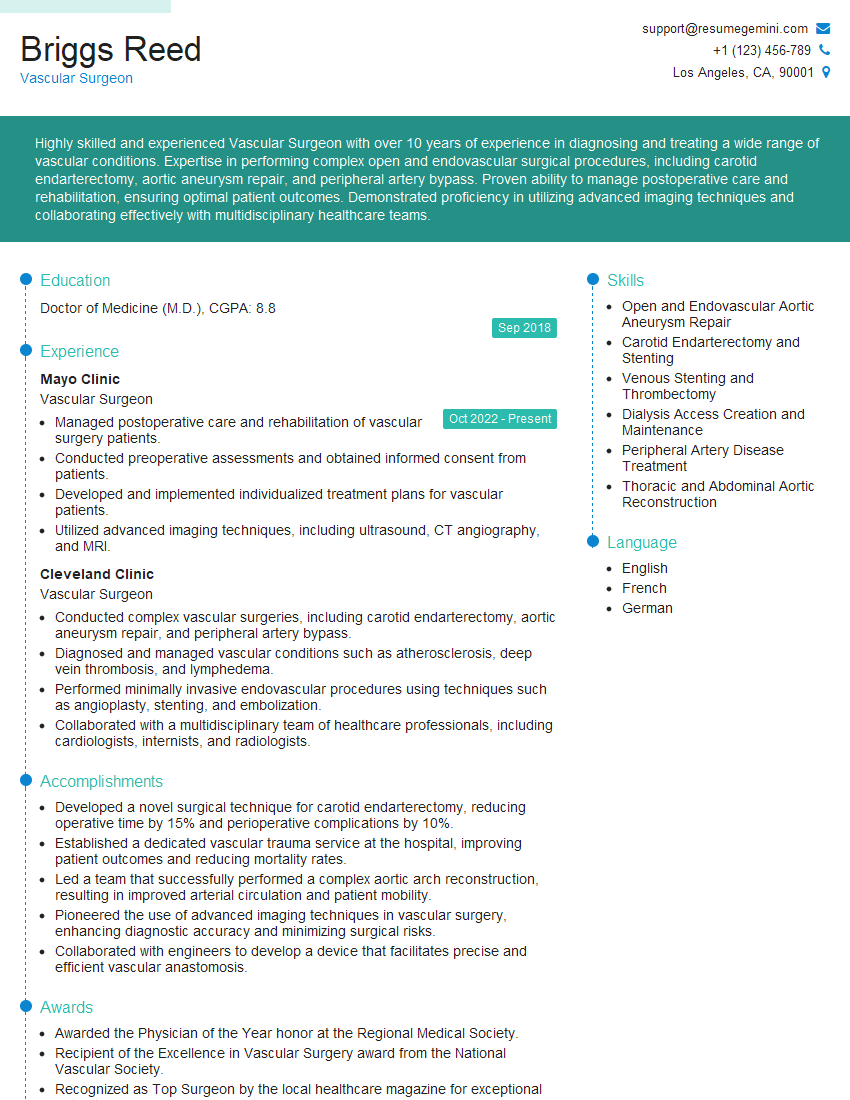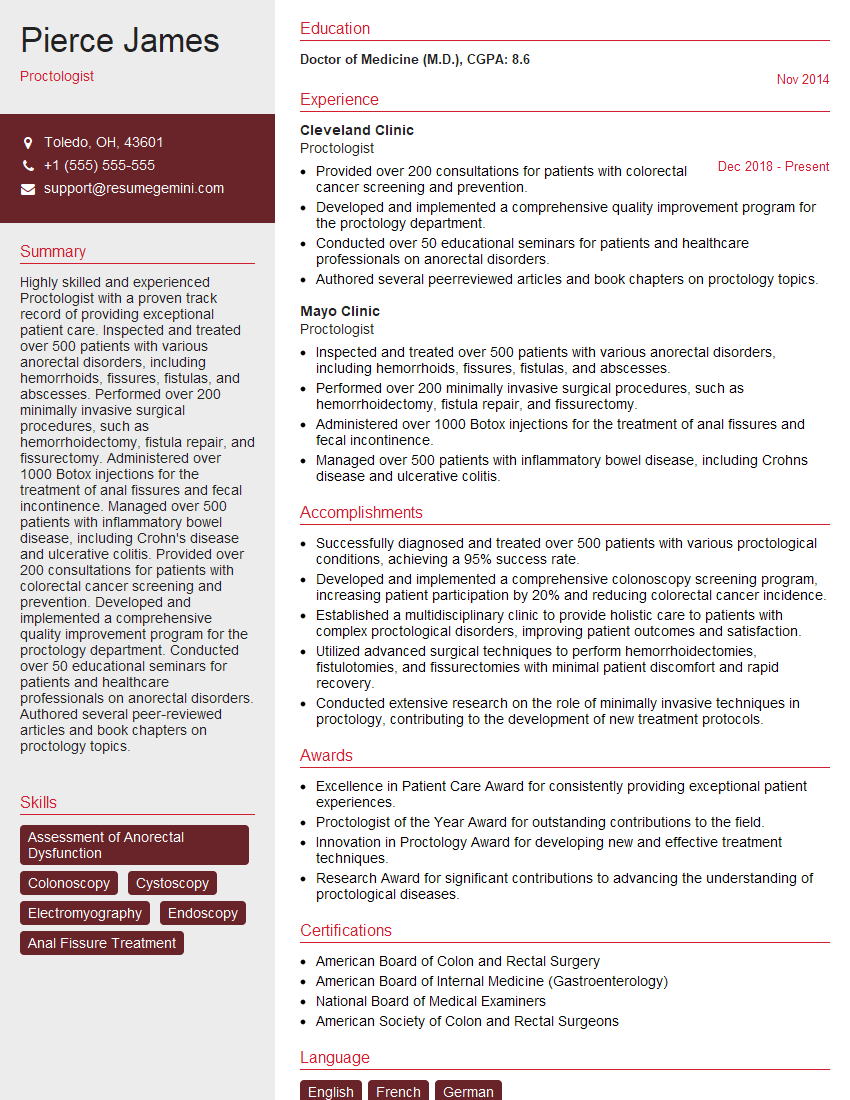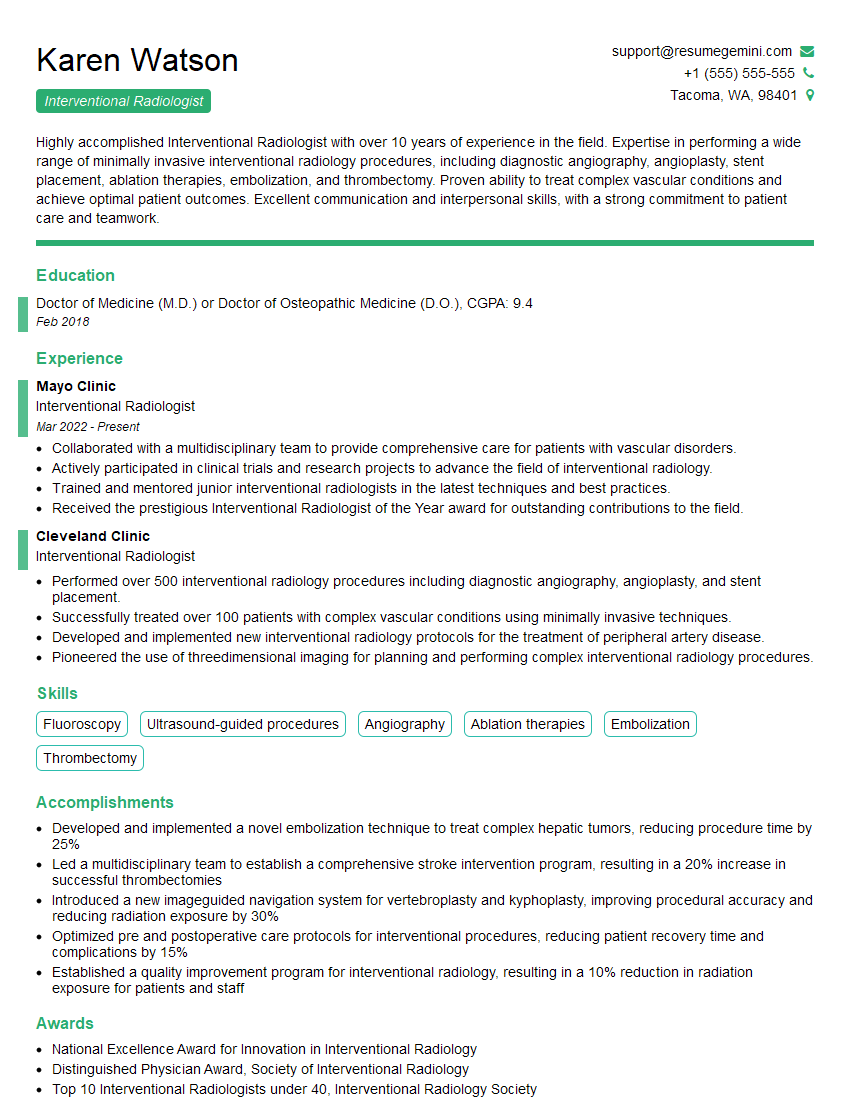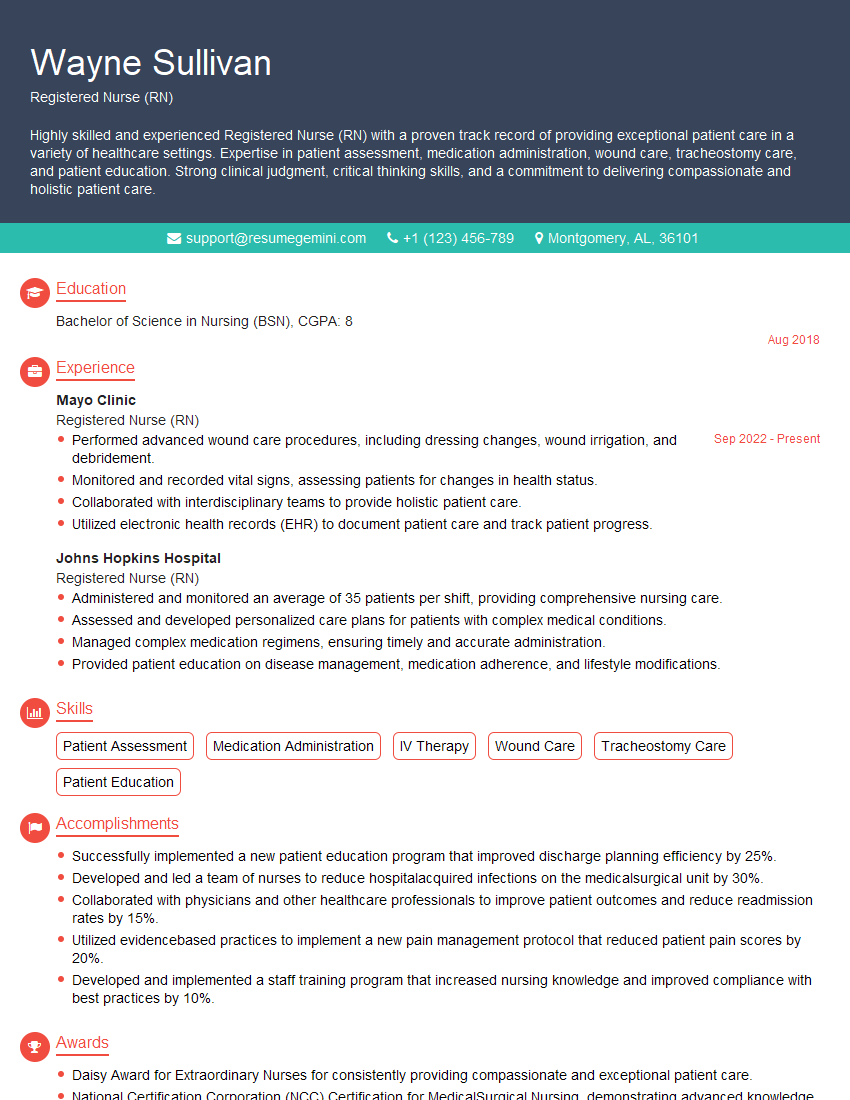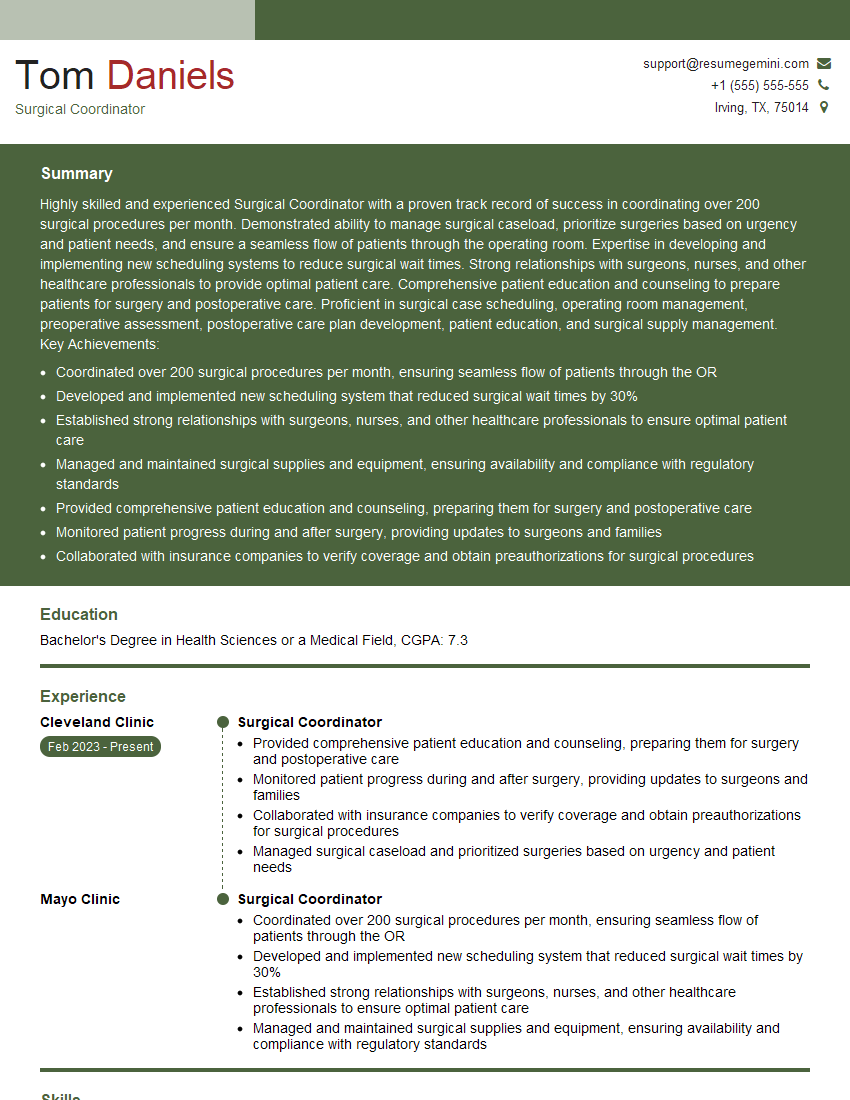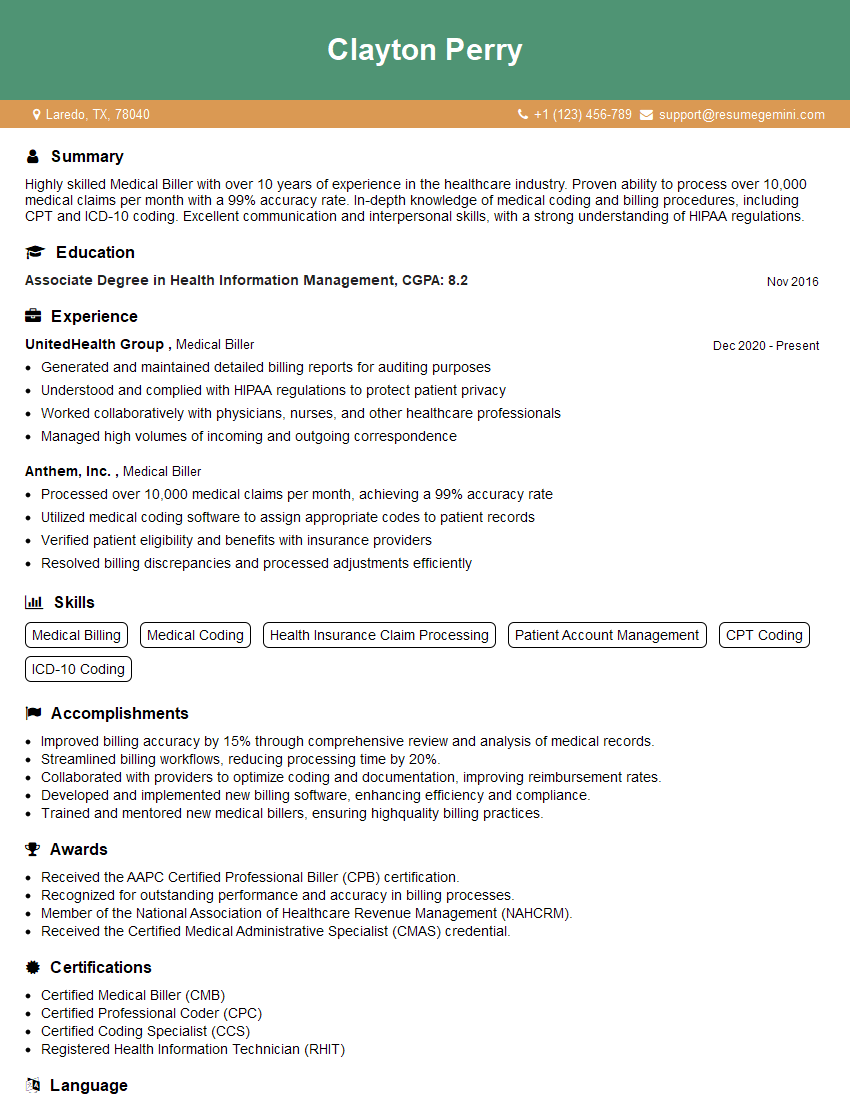Unlock your full potential by mastering the most common Tumescent Technique for Hemorrhoid Treatment interview questions. This blog offers a deep dive into the critical topics, ensuring you’re not only prepared to answer but to excel. With these insights, you’ll approach your interview with clarity and confidence.
Questions Asked in Tumescent Technique for Hemorrhoid Treatment Interview
Q 1. Describe the process of preparing a patient for tumescent hemorrhoid treatment.
Preparing a patient for tumescent hemorrhoid treatment involves a thorough assessment and explanation of the procedure. First, we conduct a complete rectal examination to accurately assess the size, location, and grade of the hemorrhoids. This helps determine the appropriate treatment strategy and injection volume. The patient’s medical history is crucial, particularly any bleeding disorders, allergies (especially to lidocaine), or concurrent infections. We also review the patient’s expectations and address any concerns they might have. Informed consent is obtained after a comprehensive discussion of the procedure, potential benefits, risks, and alternative treatment options. Finally, the patient is instructed to cleanse the bowel with an enema or laxative the day before the procedure to ensure optimal visualization during the injection. This preparation allows for a more comfortable and effective procedure.
Q 2. What are the key components of the tumescent solution used in this procedure?
The tumescent solution is the cornerstone of this technique. It’s a mixture carefully designed for effective hemostasis and anesthesia. The key components are:
- Lidocaine: A local anesthetic to numb the area, minimizing discomfort during and after the procedure. We typically use a concentration of 0.5% to 1%, ensuring effective anesthesia without significant systemic effects.
- Epinephrine (adrenaline): A vasoconstrictor that reduces bleeding by constricting blood vessels. This is crucial for clear visualization during the injection and minimizes post-procedural bleeding. The concentration is typically low, usually 1:100,000 or 1:200,000 to avoid excessive vasoconstriction or adverse effects.
- Sodium Bicarbonate: A buffer added to neutralize the acidity of lidocaine, which can cause pain if injected directly. This ensures a more comfortable injection experience for the patient.
- Sterile Water: Used as the diluent to reach the desired concentration and volume.
The exact proportions are tailored to the individual patient and the extent of the hemorrhoidal disease. The solution is always prepared aseptically to minimize the risk of infection.
Q 3. Explain the injection technique for tumescent hemorrhoid treatment.
The injection technique is precise and requires skill. The patient is positioned comfortably in the left lateral decubitus position or prone position, with the buttocks exposed. After cleansing the anal area with an antiseptic solution, a small gauge needle (typically 25-gauge or smaller) is used to inject the tumescent solution. The injection is performed circumferentially around each hemorrhoid, creating a ring of swelling. We begin by injecting into the submucosal tissues surrounding the hemorrhoid, creating a cushion of anesthetic and vasoconstricted tissue. Multiple injections are often necessary to ensure complete infiltration. The injection should be slow and steady to avoid discomfort and to ensure even distribution of the solution. Throughout the process, constant visual assessment of the injection site is key to avoid accidental intravascular injection.
Q 4. How do you determine the appropriate injection volume and sites?
Determining the appropriate injection volume and sites is crucial for successful treatment. The volume is not fixed but depends on the size and number of hemorrhoids. A larger hemorrhoid will require a larger volume of solution. The injection sites are strategically chosen to completely infiltrate the submucosal tissue surrounding the hemorrhoid. We avoid injecting directly into the hemorrhoid itself. The goal is to create a well-defined and evenly distended tumescent cushion, which helps to reduce the hemorrhoid’s size and constrict blood flow. Experience and careful assessment are vital to judge the adequate injection volume and locations.
For example, a small internal hemorrhoid might need only 2-3 ml of solution, while a large external hemorrhoid might require 5-10 ml or more. The injection sites are adjusted based on the individual patient anatomy and the location of the hemorrhoids. Palpation and visualization assist in the guidance of this process. We monitor the patient closely for signs of discomfort or distension to adjust the volume accordingly.
Q 5. What are the potential complications of tumescent hemorrhoid treatment?
While generally safe, tumescent hemorrhoid treatment carries some potential complications. These are relatively rare when the procedure is performed by an experienced practitioner. Possible complications include:
- Pain: Although the tumescent solution is designed to minimize pain, some discomfort might occur during or after the procedure. This is usually mild and can be managed with analgesics.
- Bleeding: Minor bleeding can occur, usually at the injection sites. This is usually self-limiting.
- Infection: Infection is a possibility, but it can be minimized with strict aseptic techniques.
- Thrombosis: In rare cases, thrombosis (blood clot formation) in the hemorrhoidal veins can occur.
- Allergic reactions: Allergic reactions to the components of the tumescent solution, particularly lidocaine, can occur, though they are uncommon.
- Necrosis: In rare instances, excessive injection pressure can lead to tissue necrosis (tissue death). This is primarily avoided with careful technique and volume control.
It’s important to discuss these potential complications with the patient before the procedure to ensure informed consent and manage expectations.
Q 6. How do you manage pain during and after the procedure?
Pain management is an important aspect of tumescent hemorrhoid treatment. The tumescent solution itself provides significant pain relief due to the local anesthetic effect of lidocaine. For minor discomfort during the procedure, we might utilize additional techniques such as reassurance and distraction. After the procedure, patients are usually advised to take over-the-counter analgesics like acetaminophen or ibuprofen to control any residual pain or discomfort. In rare cases, stronger analgesics might be necessary. Warm sitz baths and high-fiber diets can also help alleviate discomfort and promote healing. Patient education regarding appropriate post-procedure care and pain management is critical to ensure a comfortable recovery.
Q 7. What are the contraindications for tumescent hemorrhoid treatment?
There are several contraindications for tumescent hemorrhoid treatment, which means the procedure shouldn’t be performed in certain situations. These include:
- Allergy to lidocaine or epinephrine: Patients with known allergies to these components of the tumescent solution should not undergo the procedure.
- Bleeding disorders: Patients with bleeding disorders (e.g., hemophilia) are at increased risk of significant bleeding.
- Severe cardiovascular disease: The use of epinephrine necessitates caution in patients with severe heart conditions.
- Pregnancy: While the risk is low, the use of epinephrine in pregnancy is generally avoided.
- Active local infection: The presence of infection near the treatment site increases the risk of complications.
- Severe liver or kidney disease: These conditions can affect the metabolism and excretion of the tumescent solution’s components.
A thorough pre-procedure assessment is vital to identify any contraindications and ensure patient safety.
Q 8. Describe the post-operative care instructions for patients.
Post-operative care after tumescent hemorrhoid treatment is crucial for optimal healing and minimizing discomfort. The instructions typically include:
- Pain Management: Over-the-counter pain relievers like ibuprofen or acetaminophen are usually sufficient. In some cases, a stronger prescription medication might be necessary.
- Hygiene: Maintaining meticulous hygiene is paramount. Gentle cleansing with warm water after each bowel movement is recommended. Avoid harsh soaps or wipes that can irritate the area. Consider using a sitz bath (soaking in warm water) several times a day to soothe the area.
- Diet: A high-fiber diet is essential to promote soft, bulky stools, preventing straining during bowel movements. Increase your intake of fruits, vegetables, and whole grains. Adequate fluid intake is also critical.
- Activity: Gentle activity is encouraged, but strenuous activities should be avoided initially to minimize strain on the treated area. Listen to your body and avoid activities that cause pain.
- Follow-up: Regular follow-up appointments are scheduled to monitor healing progress and address any concerns. This allows for early detection of complications and ensures the treatment is effective.
- Wound Care: The doctor might provide specific instructions regarding dressing changes if needed. If any excessive bleeding or unexpected symptoms occur, seek immediate medical attention.
Remember, every patient’s recovery is unique. Following your doctor’s specific instructions is critical for a successful outcome. For example, one patient might heal faster than another, requiring only a few days of post-operative care, while another might need a longer period of rest and pain management.
Q 9. How do you differentiate between internal and external hemorrhoids?
Differentiating between internal and external hemorrhoids is based on their location relative to the dentate line (the point where the anal lining changes).
- Internal hemorrhoids are located above the dentate line, inside the rectum. They are usually painless unless they prolapse (bulge out) or become thrombosed (blood clot forms). You may not be aware of them unless they cause bleeding during bowel movements.
- External hemorrhoids are located below the dentate line, under the skin around the anus. These are often painful, especially if they become thrombosed. They can be easily seen and felt as a lump or swelling around the anus. A thrombosed external hemorrhoid is a painful, swollen clot under the skin and often requires immediate treatment.
Think of it like this: internal hemorrhoids are hidden; external hemorrhoids are visible. A thorough physical exam by a physician is essential for accurate diagnosis.
Q 10. What are the different grades of hemorrhoids and how does treatment vary?
Hemorrhoids are graded based on their severity and prolapse:
- Grade I: Internal hemorrhoids that don’t prolapse outside the anus.
- Grade II: Internal hemorrhoids that prolapse during defecation but spontaneously reduce (return to their normal position).
- Grade III: Internal hemorrhoids that prolapse during defecation and require manual reduction (pushing them back in).
- Grade IV: Internal hemorrhoids that are permanently prolapsed and cannot be reduced.
Treatment varies significantly based on the grade. Grade I and II hemorrhoids are often managed conservatively with lifestyle changes (fiber, hydration) and topical medications. Grades III and IV often require more intervention, such as rubber band ligation, sclerotherapy (including tumescent sclerotherapy), or surgery. Tumescent sclerotherapy is particularly useful for Grades II and III hemorrhoids that respond poorly to conservative methods.
Q 11. Explain the role of ultrasound in evaluating hemorrhoids.
Ultrasound, particularly endoanal ultrasound, plays a vital role in hemorrhoid evaluation, especially for internal hemorrhoids which might not be readily visible during a physical exam. Endoanal ultrasound provides high-resolution images of the anal canal and rectum. It helps:
- Visualize hemorrhoidal tissue: Determine the size, location, and extent of hemorrhoidal involvement.
- Assess the severity: Distinguish between different grades of hemorrhoids, helping to determine the most appropriate treatment.
- Identify complications: Detect conditions such as thrombosis (blood clot formation) or incarceration (a trapped hemorrhoid).
- Guide treatment: Help guide minimally invasive procedures such as rubber band ligation by precisely locating the hemorrhoids.
In simpler terms, ultrasound acts like a sophisticated magnifying glass, providing a detailed picture of the inside of the anal canal, enabling more precise diagnosis and tailored treatment planning.
Q 12. How do you assess the effectiveness of the tumescent treatment?
Assessing the effectiveness of tumescent treatment involves a multi-faceted approach focusing on both subjective and objective measures.
- Symptom Improvement: This is the primary indicator of success. Patients are assessed for a reduction in bleeding, pain, itching, and prolapse. Questionnaires or visual analog scales can be used to quantify these improvements.
- Physical Examination: A repeat physical examination assesses the size and condition of the hemorrhoids. Has the swelling reduced? Is there less prolapse? Is the patient more comfortable?
- Follow-up Colonoscopy or Proctoscopy: For internal hemorrhoids, a follow-up examination using a colonoscopy or proctoscopy may be performed to visualize the treated area and assess the healing.
- Patient Satisfaction: Patient satisfaction is important and should be assessed. The treatment’s effectiveness is partly determined by whether the patient feels their quality of life has improved.
For example, a patient with significant bleeding before treatment might report minimal or no bleeding after tumescent sclerotherapy, indicating the treatment’s efficacy. Likewise, a reduction in the size of visible hemorrhoids during physical examination confirms the treatment’s success.
Q 13. What are the alternative treatment options for hemorrhoids?
Numerous alternative treatments for hemorrhoids exist, ranging from conservative measures to surgical interventions. The choice of treatment depends on the severity, type, and patient preference.
- Lifestyle Changes: Increasing fiber intake, drinking plenty of fluids, and regular exercise to prevent constipation are fundamental.
- Topical Treatments: Creams and ointments containing corticosteroids or anesthetic agents can relieve pain, itching, and inflammation.
- Rubber Band Ligation: A minimally invasive procedure where a small rubber band is placed around the base of an internal hemorrhoid to cut off its blood supply.
- Infrared Coagulation: Uses infrared light to cauterize and destroy hemorrhoidal tissue.
- Hemorrhoidectomy: Surgical removal of hemorrhoids, typically reserved for severe cases resistant to other treatments.
- Stapled Hemorrhoidopexy: A surgical technique to reposition and reduce hemorrhoidal tissue.
Conservative measures are often the first line of treatment, and surgical options are considered when conservative treatments fail to provide adequate relief.
Q 14. What is the difference between tumescent sclerotherapy and other injection techniques?
The key difference between tumescent sclerotherapy and other injection techniques lies in the use of a tumescent solution.
- Tumescent sclerotherapy involves injecting a solution containing a local anesthetic (like lidocaine) and a vasoconstrictor (like epinephrine) into the hemorrhoidal tissue. This creates a swollen, distended area (tumescence) that makes the injection more comfortable, reduces bleeding during the procedure, and may help reduce post-procedure pain and swelling. The sclerosing agent is then injected to cause fibrosis (scarring) and reduce the size of the hemorrhoid.
- Other injection techniques may use different solutions containing only a sclerosing agent without the anesthetic and vasoconstricting components of the tumescent solution. These techniques are likely to be more painful and may result in more bleeding and post-procedure discomfort.
In essence, tumescent sclerotherapy enhances patient comfort and minimizes complications through its unique combination of anesthetic and vasoconstrictive effects. It’s a more refined approach to injection therapy, leading to better patient outcomes compared to simpler injection techniques.
Q 15. Discuss the potential for recurrence after tumescent hemorrhoid treatment.
Recurrence after tumescent hemorrhoid treatment is a possibility, though the rate is generally lower compared to other hemorrhoid treatment methods. The likelihood depends on several factors, including the severity of the hemorrhoids before treatment, patient adherence to post-procedure care instructions, and the individual’s predisposition to developing hemorrhoids. For example, a patient with grade I-II hemorrhoids treated meticulously is far less likely to experience recurrence than someone with grade III-IV hemorrhoids who doesn’t follow post-operative dietary and lifestyle changes. We aim to minimize recurrence by ensuring complete injection and sclerotherapy of affected tissues. However, it’s crucial to manage expectations and advise patients that while the procedure offers significant improvement, there’s a small chance of recurrence, necessitating potential follow-up treatment.
Factors influencing recurrence include inadequate initial treatment, pre-existing contributing factors like chronic constipation or straining during bowel movements, and variations in individual healing responses. Post-operative lifestyle changes, including a high-fiber diet and regular exercise, are vital to reduce recurrence risks. We discuss these lifestyle modifications thoroughly during the pre-operative consultation.
Career Expert Tips:
- Ace those interviews! Prepare effectively by reviewing the Top 50 Most Common Interview Questions on ResumeGemini.
- Navigate your job search with confidence! Explore a wide range of Career Tips on ResumeGemini. Learn about common challenges and recommendations to overcome them.
- Craft the perfect resume! Master the Art of Resume Writing with ResumeGemini’s guide. Showcase your unique qualifications and achievements effectively.
- Don’t miss out on holiday savings! Build your dream resume with ResumeGemini’s ATS optimized templates.
Q 16. How do you counsel patients regarding expectations and potential risks?
Patient counseling is a crucial aspect of tumescent hemorrhoid treatment. I begin by explaining the procedure in detail, using straightforward language avoiding medical jargon. I use visual aids like diagrams to illustrate the process and show what to expect. Realistic expectations are set, highlighting the procedure’s benefits while acknowledging potential discomfort, swelling, and bruising during the initial recovery period. I emphasize that this is not a ‘cure-all’ and that continued lifestyle modifications are crucial for long-term success.
Potential risks, including bleeding, infection, and recurrence, are discussed openly and honestly. I explain the likelihood and severity of each risk, providing examples based on my experience. For instance, I might say, “While infection is rare, if it were to occur, it could involve symptoms such as increased pain, redness, or pus, which would necessitate antibiotic treatment.” I also address patient concerns and answer all their questions, ensuring they understand the procedure’s benefits and risks before proceeding. A signed informed consent form ensures they fully understand and agree to the treatment.
Q 17. Describe your experience with managing complications such as bleeding or infection.
Managing complications is a key part of my practice. Bleeding is usually minimal and often self-limiting. However, excessive bleeding requires prompt intervention, which may involve local pressure, cauterization, or, in rare cases, surgical repair. Infection is uncommon with proper sterile technique. If infection does occur, we initiate antibiotic therapy immediately, closely monitoring the patient’s response. I typically prescribe oral antibiotics and provide clear instructions on wound care to promote healing. Regular follow-up appointments allow for early identification and management of any emerging complications, ensuring timely intervention minimizes potential adverse effects.
For example, I recall a patient who experienced mild bleeding after the procedure. Applying direct pressure for about 15 minutes effectively controlled the bleeding. Another case involved a small localized infection which resolved quickly with a course of oral antibiotics and regular wound cleaning. Thorough documentation of such events is critical for quality control and patient safety.
Q 18. How do you handle patient anxiety or fear related to the procedure?
Addressing patient anxiety and fear is paramount. I start by actively listening to their concerns and validating their feelings. I create a safe and comfortable environment during the consultation, offering reassurance and answering questions patiently. I explain the procedure step-by-step, using analogies to make the process less daunting. For instance, I might compare the injection to a small mosquito bite. I demonstrate empathy, recognizing that this is a sensitive area, and allow time for the patient to ask questions and express their apprehensions. Pre-operative medication, like mild anxiety-reducing medication, can be discussed and prescribed as needed, to further alleviate anxiety. Positive reinforcement and support are crucial throughout the entire process.
Q 19. What are the appropriate needle sizes and types for tumescent injections?
The choice of needle size and type for tumescent injections is crucial for effective and safe treatment. We typically use a 25-gauge or 27-gauge needle for the initial infiltration. These smaller gauges minimize trauma and bleeding during the injection process. The needle type is usually a standard hypodermic needle, though some physicians may prefer a longer needle for deeper injections depending on the hemorrhoid’s location and size. The choice of gauge also depends on the viscosity of the tumescent solution, with smaller gauges preferred for less viscous solutions.
Using too large a gauge can cause excessive trauma and pain, while too small a gauge can make injection challenging and slow down the process. I always explain the rationale for the needle size selected to the patient, emphasizing patient comfort and minimizing discomfort. The selection is also guided by the patient’s individual needs and characteristics.
Q 20. How do you ensure sterile technique during the procedure?
Maintaining a sterile technique is paramount to prevent infection. Before the procedure, we thoroughly cleanse and disinfect the perianal area using a suitable antiseptic solution. We use sterile gloves, drapes, and instruments throughout the procedure. The tumescent solution itself is prepared aseptically. All materials that come into contact with the patient’s skin or tissues are sterile and disposed of properly after use. The entire procedure is conducted in a clean and well-lit environment to minimize the risk of contamination. We adhere to strict infection control protocols, similar to those used in any minor surgical procedure.
This includes meticulous hand hygiene, using a sterile field, and employing proper waste disposal methods. Regular audits and training reinforce the importance of sterile technique amongst our clinical team.
Q 21. Explain the importance of proper documentation for this procedure.
Proper documentation is crucial for several reasons. First, it provides a detailed record of the procedure, including the technique used, the amount and type of solution injected, the patient’s response, and any complications encountered. This comprehensive record aids in tracking patient progress and outcomes. Second, accurate documentation protects both the patient and the healthcare provider in case of legal issues or insurance claims. It establishes a clear timeline of events and supports clinical decision-making. Third, thorough documentation enables the development of improved clinical protocols by identifying trends and areas requiring refinement in technique or post-operative care.
Our documentation includes pre-operative assessment, the procedural details, post-operative instructions, and follow-up notes. We also document any complications, treatments administered, and the patient’s response to treatment. This meticulous record-keeping ensures patient safety and legal compliance while contributing to ongoing quality improvement in our practice.
Q 22. What are the legal and ethical considerations related to this treatment?
The legal and ethical considerations surrounding tumescent hemorrhoid treatment are multifaceted. Primarily, informed consent is paramount. Patients must fully understand the procedure, its risks (such as bleeding, infection, pain, and recurrence), and available alternatives before giving consent. This involves clear, concise communication, free from coercion, using language the patient understands. Maintaining patient confidentiality, adhering to HIPAA regulations (in the US), and proper documentation of the procedure and patient interactions are also critical. Further, accurate billing and avoiding unnecessary procedures are ethically crucial. For example, I would never recommend tumescent therapy for a patient who would be better served by other less invasive treatments like lifestyle changes or rubber band ligation. Finally, ongoing professional development is essential to ensure I practice within the current standards of care and legal frameworks. Any complications must be promptly addressed and documented responsibly.
Q 23. How do you stay updated on the latest advancements in hemorrhoid treatment?
Staying current in hemorrhoid treatment involves a multi-pronged approach. I actively participate in professional organizations like the American Society of Colon and Rectal Surgeons (ASCRS) to access their publications and attend continuing medical education (CME) courses and conferences. These conferences often feature presentations on cutting-edge research and new techniques. I regularly review peer-reviewed medical journals such as The American Journal of Gastroenterology and Diseases of the Colon & Rectum for the latest findings on hemorrhoid treatment. Additionally, I participate in online medical communities and forums to discuss challenging cases and learn from my colleagues’ experiences. Staying abreast of new technologies and techniques is crucial for offering patients the best possible care.
Q 24. Describe your experience with different types of hemorrhoidal banding techniques.
My experience encompasses various hemorrhoidal banding techniques, each with its own strengths and weaknesses. Rubber band ligation is a common technique, effective for internal hemorrhoids. I’ve also utilized advanced banding techniques with specialized devices offering improved precision and control. The choice of technique depends heavily on the patient’s specific condition, the size and location of the hemorrhoids, and their overall health. For instance, a patient with multiple large internal hemorrhoids might benefit from a staged approach, while a patient with a single small hemorrhoid would be a suitable candidate for a simpler rubber band ligation. Skill and experience are critical in selecting and performing the most appropriate banding procedure. I also carefully explain the potential risks and benefits of each method to the patient.
Q 25. What is your experience with rubber band ligation?
Rubber band ligation is a cornerstone of my hemorrhoid treatment approach. It’s a minimally invasive procedure where a small rubber band is placed around the base of an internal hemorrhoid, cutting off its blood supply. This leads to the hemorrhoid sloughing off within a week or two. My experience shows it’s highly effective for smaller, internal hemorrhoids, with a relatively low complication rate. However, it’s crucial to correctly identify the hemorrhoid and ensure proper band placement to avoid complications. I meticulously explain the procedure, expected discomfort, and potential risks like mild bleeding or pain. Post-procedure instructions, including dietary recommendations, are equally important for a successful outcome. For instance, I often recommend a high-fiber diet to facilitate easier bowel movements and reduce straining.
Q 26. How do you differentiate between a thrombosed hemorrhoid and other conditions?
Differentiating a thrombosed hemorrhoid from other conditions requires a thorough examination. A thrombosed hemorrhoid presents as a painful, swollen, bluish lump, typically located externally. This differs from other conditions such as an anal fissure (a tear in the anal lining), an abscess (a collection of pus), or a perianal hematoma (a blood clot outside the hemorrhoid). The history is crucial; a thrombosed hemorrhoid often develops suddenly after straining, whereas a fissure may present with chronic pain and bleeding. A thorough physical exam, inspecting the perianal area and potentially performing a digital rectal exam (with the patient’s consent), helps clarify the diagnosis. Imaging studies such as anoscopy or proctoscopy might be necessary in ambiguous cases. In some cases, a biopsy may be required to rule out malignancy. This differential diagnosis process ensures the appropriate treatment is administered.
Q 27. Describe your experience with managing patients with co-morbidities affecting hemorrhoid treatment.
Managing patients with comorbidities impacting hemorrhoid treatment demands a holistic approach. For instance, a patient with bleeding disorders would require careful assessment of the risks of bleeding before any intervention. Patients on anticoagulants may need adjustments to their medication regimen or alternative treatment options explored. Diabetic patients may have slower healing times, necessitating close monitoring for infection and meticulous wound care. Similarly, patients with heart conditions may require pre-procedural cardiac clearance. Communication with the patient’s other specialists is vital in coordinating care. Adapting treatment strategies based on individual circumstances is essential for minimizing risks and optimizing outcomes. I always prioritize the patient’s overall health and well-being when making treatment decisions.
Q 28. What are the limitations of tumescent hemorrhoid treatment?
While tumescent hemorrhoid treatment offers advantages like reduced pain and bleeding, it does have limitations. It’s not suitable for all hemorrhoid types, particularly large or severe internal hemorrhoids. It’s also not as effective for external hemorrhoids or thrombosed hemorrhoids. The procedure may be less effective in patients who are obese or have significant underlying medical conditions affecting healing. Recurrence is possible, and the results might not be as durable as other procedures such as surgery. Finally, the effectiveness depends largely on the surgeon’s skill and experience. Therefore, open communication with the patient regarding the limitations and alternative treatment options is crucial for realistic expectations and shared decision-making.
Key Topics to Learn for Tumescent Technique for Hemorrhoid Treatment Interview
- Anatomy and Physiology of Hemorrhoids: Understanding the vascular and anatomical structures involved is crucial for effective treatment planning and execution.
- Tumescent Solution Preparation and Injection Techniques: Mastering the precise preparation and injection methods ensures patient safety and optimal treatment outcomes. This includes understanding the role of different anesthetic agents and their concentrations.
- Patient Selection and Assessment: Learn to identify suitable candidates and contraindications for the Tumescent Technique. This includes understanding potential risks and complications.
- Procedure Steps and Techniques: Thorough knowledge of the step-by-step process, including pre-operative preparation, intra-operative maneuvers, and post-operative care, is essential.
- Managing Complications and Adverse Events: Prepare for questions on how to identify, manage, and prevent potential complications like bleeding, infection, or nerve damage.
- Post-Operative Care and Patient Education: Understand the importance of providing clear and comprehensive instructions to patients for optimal recovery and minimizing recurrence.
- Comparison with Other Hemorrhoid Treatment Methods: Be prepared to discuss the advantages and disadvantages of the Tumescent Technique compared to other approaches like rubber band ligation or surgical hemorrhoidectomy.
- Evidence-Based Practice and Research: Familiarize yourself with current research and clinical guidelines supporting the use of the Tumescent Technique in hemorrhoid treatment.
Next Steps
Mastering the Tumescent Technique for Hemorrhoid Treatment will significantly enhance your career prospects in the field of proctology and colorectal surgery. A strong understanding of this technique demonstrates advanced skills and a commitment to providing high-quality patient care. To increase your chances of landing your dream role, focus on building an ATS-friendly resume that showcases your expertise. ResumeGemini is a trusted resource that can help you create a compelling and effective resume, ensuring your application stands out from the competition. Examples of resumes tailored to Tumescent Technique for Hemorrhoid Treatment are available to guide you through this process.
Explore more articles
Users Rating of Our Blogs
Share Your Experience
We value your feedback! Please rate our content and share your thoughts (optional).
What Readers Say About Our Blog
This was kind of a unique content I found around the specialized skills. Very helpful questions and good detailed answers.
Very Helpful blog, thank you Interviewgemini team.

